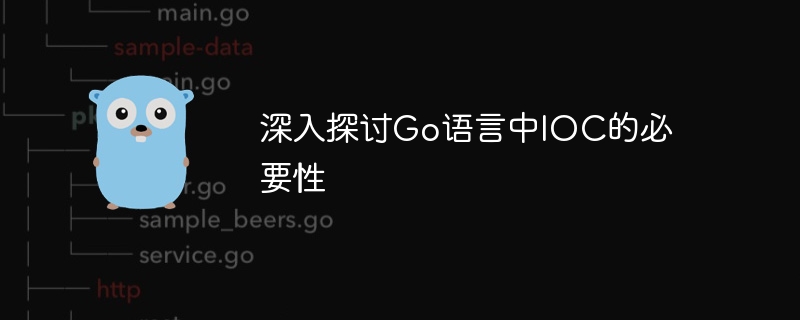

In the Go language, dependency injection (Inversion of Control, referred to as IOC) is a common programming pattern, which can effectively reduce the coupling between components and make the code more efficient. Flexible and maintainable. In this article, we will delve into the necessity of IOC in the Go language and illustrate its implementation and advantages through specific code examples.
First, let us understand what dependency injection is. Dependency injection is a method of realizing relationships between objects by injecting dependent objects externally. Simply put, it is to pass in the dependent objects required by an object from the outside, instead of directly creating or finding dependent objects inside the object. The advantage of this is that it reduces the coupling between objects, making the code easier to test, maintain and expand.
In the Go language, dependency injection is usually implemented through an interface to define the behavior of the dependent object, and then the instance of the dependent object is passed in the constructor of the object. Let us illustrate with a simple example:
package main
import "fmt"
// 定义接口
type Greeter interface {
Greet()
}
// 实现一个实现Greeter接口的类型
type EnglishGreeter struct{}
func (e *EnglishGreeter) Greet() {
fmt.Println("Hello, World!")
}
// 使用依赖注入的方式创建一个需要Greeter依赖对象的类型
type GreetingApp struct {
greeter Greeter
}
func NewGreetingApp(greeter Greeter) *GreetingApp {
return &GreetingApp{greeter}
}
func (ga *GreetingApp) Run() {
ga.greeter.Greet()
}
func main() {
// 通过依赖注入的方式创建GreetingApp对象
app := NewGreetingApp(&EnglishGreeter{})
app.Run()
}In the above example, we have defined a Greeter interface and a type EnglishGreeter that implements the interface. We then define a type GreetingApp that requires a Greeter dependency object and receive the Greeter object in its constructor. Finally, in the main function, we created the GreetingApp object through dependency injection, passed in an EnglishGreeter object, and called its Run method to implement the function of printing "Hello, World!".
Through the above code example, we can see the process of implementing IOC through dependency injection in the Go language, which can reduce the coupling between objects and make the code easier to test and maintain. In addition, dependency injection can also easily implement dependency replacement and change the behavior of dependent objects, thereby enhancing the flexibility of the code.
To sum up, we can conclude that in Go language, dependency injection is a very effective programming model that can reduce the coupling between codes and enhance the flexibility and maintainability of the code. sex. Through specific code examples, we can better understand the concept and implementation of IOC, and thus better apply it in actual project development.
The above is the detailed content of An in-depth discussion of the necessity of IOC in Go language. For more information, please follow other related articles on the PHP Chinese website!
 Usage of Type keyword in Go
Usage of Type keyword in Go
 How to implement linked list in go
How to implement linked list in go
 What are the Go language programming software?
What are the Go language programming software?
 How to learn go language from 0 basics
How to learn go language from 0 basics
 What are the methods to implement operator overloading in Go language?
What are the methods to implement operator overloading in Go language?
 What are the operators in Go language?
What are the operators in Go language?
 http 400 Bad Request
http 400 Bad Request
 msdn official website entrance
msdn official website entrance




